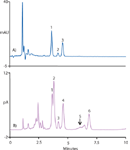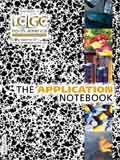HPLC Stevia Sweetener Analysis with CAD and UV Detection
In December 2008, the United States FDA recognized rebaudioside A (reb. A) purified from Stevia rebaudiana (Bertoni) as Generally Recognized as Safe (GRAS) as a sugar substitute in foods. As a result, stevia products have become popular tabletop and beverage sweeteners. Two steviol glycosides, stevioside and reb. A, are largely responsible for the desired sweet flavor, with reb. A preferred for sweeteners (1).
In December 2008, the United States FDA recognized rebaudioside A (reb. A) purified from Stevia rebaudiana (Bertoni) as Generally Recognized as Safe (GRAS) as a sugar substitute in foods. As a result, stevia products have become popular tabletop and beverage sweeteners. Two steviol glycosides, stevioside and reb. A, are largely responsible for the desired sweet flavor, with reb. A preferred for sweeteners (1).
Steviol glycoside determination is challenging for multiple reasons. The steviol glycosides structures are quite similar differing only in small glycosylation changes, which makes chromatographic separations challenging. Also, the sensitive detection of these compounds can be difficult. This work describes a stable determination method for steviol glycosides in commercial sweeteners.
Experimental
A Thermo Scientific Dionex UltiMate™ RSLC system with a HPG-3400RS pump, a TCC-3000RS column compartment, a WPS-3000TRS autosampler, a DAD-3000RS detector, and a Thermo Scientific Dionex Corona™ ultra™ detector were used for this work. A Thermo Scientific Acclaim™ Trinity™ P1 (3 μm), 2.1 × 100 mm column was used for all separations at 20 °C with an isocratic elution of 81/19 acetonitrile/10 mM ammonium formate, pH = 3.0 at 0.3 mL/min. Thermo Scientific Dionex Chromeleon™ Chromatography Data System (CDS) software was used for system control and data processing.
Results and Discussion
Figure 1 shows the steviol glycoside separation when analyzing a commercial stevia leaf extract sweetener with both UV and CAD. Reb. A quantification is within experimental error by both detection methods. The method is sensitive, with reb. A LOQs of 7.0 μg/mL (UV-210 nm) and 2.3 μg/mL (CAD). Retention time precision is excellent with RSDs between 0.07–0.25. Retention time variability between mobile phase batches was within 1.3% for reb. A suggesting the method is rugged.

Figure 1: Separation of Brand A sweetener on the Acclaim Trinity P1 column and detected by A) UV detection-210 nm and B) CAD. Peaks: A) 1-stevioside (0.032 mg/mL), 2- rebaudioside C, 3- rebaudioside A (0.035 mg/mL). Peaks: B) 1-stevioside (0.028 mg/mL), 2- inulin, 3-rebaudioside C, 4- rebaudioside A (0.038 mg/mL), 5- steviolbioside (0.002 mg/mL) 6- unknown.
Steviol glycosides are determined here in consumer sweeteners. This method uses the HILIC mode of the Acclaim Trinity P1 column allowing consistent separation of multiple steviol glycosides. By using a volatile mobile phase, CAD detection is allowed, which adds method flexibility for glycoside detection.
References
(1) I. Prakash, G.E. DuBois, J.F. Clos, K.L. Wilkens, and L.E. Fosdick, Food and Chem. Toxicol. 46, S75–S82 (2008).
All trademarks and registered trademarks are the property of Thermo Fisher Scientific Inc. and its subsidiaries.
Dionex, now part of Thermo Fisher Scientific
1228 Titan Way, P.O. Box 3603, Sunnyvale, CA 94088
tel. (408) 737-0700, fax (408) 730-9403
Website: www.thermoscientific.com/dionex


.png&w=3840&q=75)

.png&w=3840&q=75)



.png&w=3840&q=75)



.png&w=3840&q=75)














